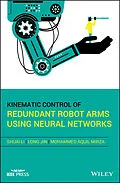Presents pioneering and comprehensive work on engaging movement in robotic arms, with a specific focus on neural networks
This book presents and investigates different methods and schemes for the control of robotic arms whilst exploring the field from all angles. On a more specific level, it deals with the dynamic-neural-network based kinematic control of redundant robot arms by using theoretical tools and simulations.
Kinematic Control of Redundant Robot Arms Using Neural Networks is divided into three parts: Neural Networks for Serial Robot Arm Control; Neural Networks for Parallel Robot Control; and Neural Networks for Cooperative Control. The book starts by covering zeroing neural networks for control, and follows up with chapters on adaptive dynamic programming neural networks for control; projection neural networks for robot arm control; and neural learning and control co-design for robot arm control. Next, it looks at robust neural controller design for robot arm control and teaches readers how to use neural networks to avoid robot singularity. It then instructs on neural network based Stewart platform control and neural network based learning and control co-design for Stewart platform control. The book finishes with a section on zeroing neural networks for robot arm motion generation.
- Provides comprehensive understanding on robot arm control aided with neural networks
- Presents neural network-based control techniques for single robot arms, parallel robot arms (Stewart platforms), and cooperative robot arms
- Provides a comparison of, and the advantages of, using neural networks for control purposes rather than traditional control based methods
- Includes simulation and modelling tasks (e.g., MATLAB) for onward application for research and engineering development
By focusing on robot arm control aided by neural networks whilst examining central topics surrounding the field, Kinematic Control of Redundant Robot Arms Using Neural Networks is an excellent book for graduate students and academic and industrial researchers studying neural dynamics, neural networks, analog and digital circuits, mechatronics, and mechanical engineering.
Autorentext
SHUAI LI, PhD, is Assistant Professor in the Department of Computing at the Hong Kong Polytechnic University.
LONG JIN, PhD, is Postdoctoral Fellow in the Department of Computing at the Hong Kong Polytechnic University.
MOHAMMED AQUIL MIRZA, M.S., is a Doctorate Research Scholar with Hong Kong Polytechnic University.
Inhalt
List of Figures xiii
List of Tables xix
Preface xxi
Acknowledgments xxv
Part I Neural Networks for Serial Robot Arm Control 1
1 Zeroing Neural Networks for Control 3
1.1 Introduction 3
1.2 Scheme Formulation and ZNN Solutions 4
1.2.1 ZNN Model 4
1.2.2 Nonconvex Function Activated ZNN Model 8
1.3 Theoretical Analyses 9
1.4 Computer Simulations and Verifications 12
1.4.1 ZNN for Solving (1.13) at t = 1 12
1.4.2 ZNN for Solving (1.13) with Different Bounds 15
1.5 Summary 16
2 Adaptive Dynamic Programming Neural Networks for Control 17
2.1 Introduction 17
2.2 Preliminaries on Variable Structure Control of the SensorActuator System 18
2.3 Problem Formulation 19
2.4 Model-Free Control of the EulerLagrange System 20
2.4.1 Optimality Condition 21
2.4.2 Approximating the Action Mapping and the Critic Mapping 21
2.5 Simulation Experiment 23
2.5.1 The Model 23
2.5.2 Experiment Setup and Results 24
2.6 Summary 25
3 Projection Neural Networks for Robot Arm Control 27
3.1 Introduction 27
3.2 Problem Formulation 29
3.3 A Modified Controller without Error Accumulation 30
3.3.1 Existing RNN Solutions 30
3.3.2 Limitations of Existing RNN Solutions 32
3.3.3 The Presented Algorithm 33
3.3.4 Stability 34
3.4 Performance Improvement Using Velocity Compensation 36
3.4.1 A Control Law with Velocity Compensation 36
3.4.2 Stability 37
3.5 Simulations 41
3.5.1 Regulation to a Fixed Position 41
3.5.2 Tracking of Time-Varying References 42
3.5.3 Comparisons 47
3.6 Summary 50
4 Neural Learning and Control Co-Design for Robot Arm Control 51
4.1 Introduction 51
4.2 Problem Formulation 52
4.3 Nominal Neural Controller Design 53
4.4 A Novel Dual Neural Network Model 54
4.4.1 Neural Network Design 54
4.4.2 Stability 56
4.5 Simulations 62
4.5.1 Simulation Setup 62
4.5.2 Simulation Results 63
4.5.2.1 Tracking Performance 63
4.5.2.2 With vs.Without Excitation Noises 64
4.6 Summary 66
5 Robust Neural Controller Design for Robot Arm Control 67
5.1 Introduction 67
5.2 Problem Formulation 68
5.3 Dual Neural Networks for the Nominal System 69
5.3.1 Neural Network Design 69
5.3.2 Convergence Analysis 71
5.4 Neural Design in the Presence of Noises 72
5.4.1 Polynomial Noises 72
5.4.1.1 Neural Dynamics 73
5.4.1.2 Practical Considerations 77
5.4.2 Special Cases 78
5.4.2.1 Constant Noises 78
5.4.2.2 Linear Noises 80
5.5 Simulations 81
5.5.1 Simulation Setup 81
5.5.2 Nominal Situation 81
5.5.3 Constant Noises 82
5.5.4 Time-Varying Polynomial Noises 86
5.6 Summary 86
6 Using Neural Networks to Avoid Robot Singularity 87
6.1 Introduction 87
6.2 Preliminaries 89
6.3 Problem Formulation 90
6.3.1 Manipulator Kinematics 90
6.3.2 Manipulability 90
6.3.3 Optimization Problem Formulation 91
6.4 Reformulation as a Constrained Quadratic Program 91
6.4.1 Equation Constraint: Speed Level Resolution 91
6.4.2 Redefinition of the Objective Function 92
6.4.3 Set Constraint 93
6.4.4 Reformulation and Convexification 94
6.5 Neural Networks for Redundancy Resolution 95
6.5.1 Conversion to a Nonlinear Equation Set 95
6.5.2 Neural Dynamics for Real-Time Redundancy Resolution 96
6.5.3 Convergence Analy...
